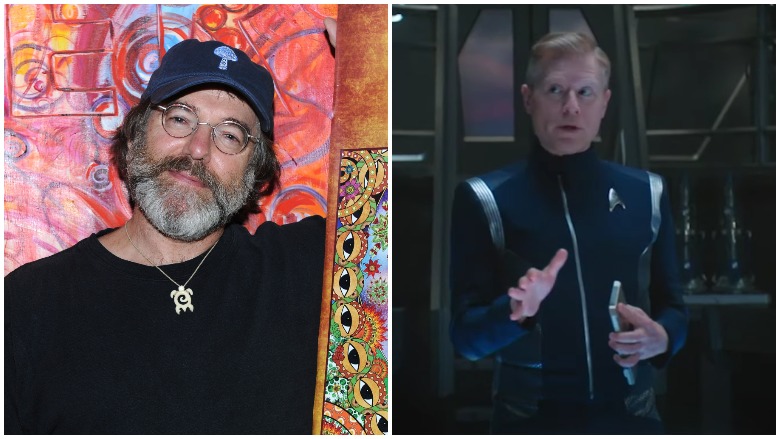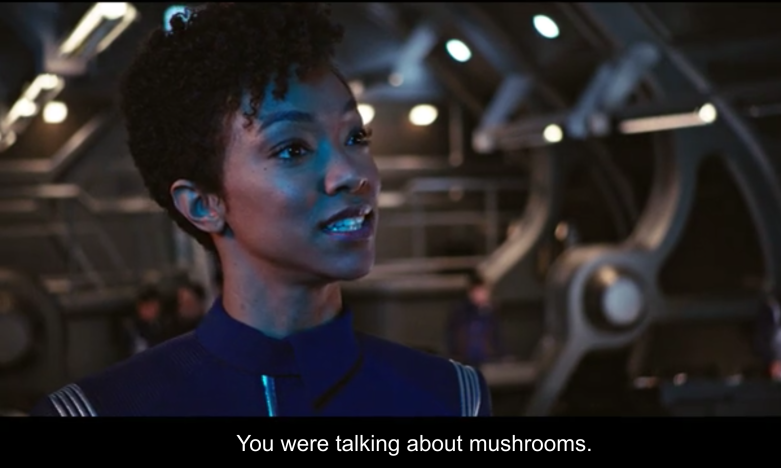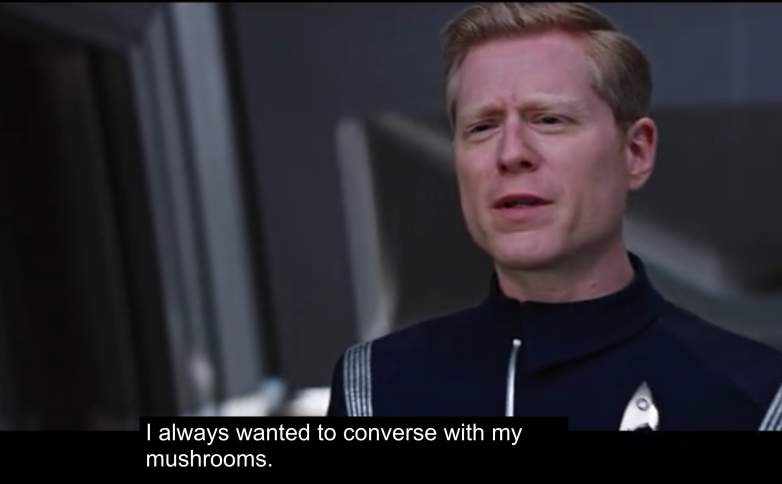
Getty/YouTube Paul Stamets is a real award-winning mycologist and author, not just a "Star Trek" character.
In 2244 in the “Star Trek” universe, the USS Discovery found a way to travel through a mycelium network using “spores harvested from prototaxites stellaviatori to jump or leap across the network,” according to Memory Alpha. Prototaxites stellaviatori is a fictional mushroom that stems from a real scientific idea. In the show, the device developed using the spores was made by two friends and colleagues, Paul Stamets (played by Anthony Rapp) and Straal.
But did you know Stamets is inspired by and named after a real-life award-winning mycologist?
Here’s what you need to know:
The Fictional Stamets Used His Own Body to Run His Invention

Paramount Plus
Their “displacement-activated spore hub drive” provided a way to use a different plane of space, called the mycelial network, for travel. “Imagine a microscopic web that spans the entire cosmos,” Captain Lorca explains to Michael Burnam in “Context Is for Kings.”
Lorca is intent on using the spore drive to flight the Klingons, as a weapon to win the war once and for all.

Paramount PlusPaul Stamets on “Star Trek.”
The fictional Stamets is the leading scientist behind the brilliance of the spore drive. In “The Butcher’s Knife Cares Not for the Lamb’s Cry,” Stamets remarks that “this entire ship was designed around my scientific specialty.” Burnam even comments that Stamets berated Straal for not growing his own mushrooms.
Stamets’ method of using the spore drive started with the tardigrade and culminated in him hooking himself in the spore drive to run it. Stamets even admits in the same episode that he “always wanted to converse with his mushrooms.”
The Fictional Spore Drive Is Grounded in Real Science by a Real Paul Stamets

GettyMycologist-author Paul Stamets.
This idea for a spore network started way before the fictional 23rd century. It actually began in the 1970s, when the real-life scientist Paul Stamets began studying fungi under an electron microscope, according to BBC Earth. Stamets offers presentations and seminars to help people understand “how mushrooms can help the health of people and planet,” according to his website Fungi Perfecti. A 2019 Forbes article describes Stamets as “a pioneer in the use of mushrooms in bioremediation, also known as ‘mycoremediation.’”
The writers on “Star Trek: Discovery” sought the real Paul Stamets’ scientific advice on how to use the spore drive in the show, based on his own research. In a 2017 interview with podcast host Joe Rogan, Stamets said the mycelium spore drive used the “internet of nature” by “tapping into the mycelial archetype.” The writers on Discovery were so grateful for Stamets’ help that they named the entire character after him.
It is not common that people get their full name and profession honored through a character in this way. In the past, according to a press release from Fungi Perfecti, “Captain Jean-Luc Picard’s name … was based on the Swiss physicist and explorer Auguste Piccard.”
Stamets said in the press release, “We have affectionately called our company StarShip FP for decades. Being a Star Trek fan since I was a kid, this is a huge honor. Mostly, I am proud that the field of Mycology will become front and center in the imaginations of young people. I hope Star Trek: Discovery will herald in new generations of mycologists for decades.”
Stamets’ Work With Mushrooms Has Some Earth-Saving Benefits
According to Stamets, “Mycology is under-funded, under-utilized and has not been recognized by thought leaders for the critical roles fungal networks – mycelium – fulfill in helping habitats, protecting biodiversity and steering sustainability. A new epoch is emerging as we explore the Mycoverse.”
In a 2008 TED Talk, Stamets posited “6 ways the mycelium fungus can help save the universe,” describing how mycelium can create natural pesticides, help clean polluted soil, prevent erosion, sequester carbon dioxide and more.
“Going way out, dark matter conforms to the same mycelial archetype. I believe matter begets life; life becomes single cells; single cells become strings; strings become chains; chains network. And this is the paradigm that we see throughout the universe,” he said.
Can Mushrooms Be Used in Real Space Travel?
Sadly, the mycelial network in space is only a fictional construct.
The fictional Stamets’ science in the world of “Star Trek: Discovery” is based purely on the spores’ connection in a vast network and the idea that “fungi, particularly mushrooms, offer some powerful, practical solutions, which can be put into practice now,” as the real Stamets says on his website Fungi Perfecti. “Unless we put into action policies and technologies that can cause a course correction in the very near future, species diversity will continue to plummet, with humans not only being the primary cause, but one of the victims.”
While we may not be able to go to black alert and use the spores to jump through the mycelial network, they could be the way to help Earth make it to 2244 in the first place.
READ NEXT: Number One: 5 Fast Facts You Need to Know